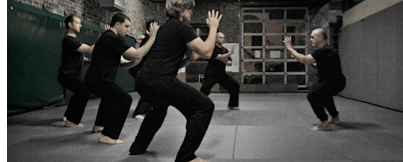




Unarmed combat is the basis of Shaolin.
Not naturally endowed with weapons, we first learn to fight with bare hands and feet. Unarmed combat is unadorned or basic fighting.
Shaolin fighting is concerned with survival.
Although Shaolin training improves strength, flexibility, respiratory function and general fitness, it never loses sight of its primary goal - survival. Shaolin unarmed combat includes grappling, throwing, joint-locking, strangling. striking, kicking, tearing and gouging. No technique is disallowed. No target is out of bounds.
The sensitive or vital-points of the body.
To be effective, techniques of defence and counter-attack are applied against points of natural weakness.
The basis of training is self-restraint.
In training, we don’t imagine we’re actually fighting. We remind ourselves we’re cooperating with friends, under controlled conditions, to master deadly fighting skills without causing or sustaining serious injury.
The basis of civil behaviour is self-control.
From the Buddhist perspective, self-control begins with self-observation. Afflictive emotions - especially anger in the context of conflict - obscure the potential clarity of mind. We slow down and observe the functions of body-mind. We learn to ‘release’ afflictive emotions before they overwhelm us.
It is better to avoid confrontations.
We prefer to back down or lose face if such behaviour prevents us from causing or sustaining serious injury or death.
If this is not an option, we fight according to the rule that in defence of life and limb there are no rules!
Stances and stepping are integral to all Shaolin fighting arts.
Stance holding cultivates stability and strength. Familiarity with complex stepping patterns cultivates agility and mobility. The twin cultivation of stability and mobility is a prerequisite for success in fighting.
Shaolin ‘lowered stances’ correct posture.
Stance training is instrumental in the correction of posture. According to the Yogacara school (the lineal precursor of Ch’an Buddhism and Shaolin) correct posture facilitates the free flow of vital energy (Greek: pneuma, Sanskrit: prana, Chinese: qi).

The free flow of vital energy underpins the feats of strength typical of advanced yogic and Shaolin masters.
Shaolin fighting techniques are exercises.
If fighting techniques are practiced to develop fitness and flexibility, they don’t cease to be fighting techniques.
Fitness and fighting ability are not the same.
Fitness is a prerequisite for any human activity. But fitness is no substitute for fighting prowess. Fighting prowess rests on technical mastery of fighting technique.
All exercises are not fighting techniques.
If skipping, running and stretching are practiced to develop fitness and flexibility, they remain exercises, Nothing can turn them into fighting techniques.
Join us on Meetup/Sydney-Shaolin for in-depth discussion forums, detailed information and subscribe to email updates on regular classes, special events, workshops, and more.
Like Shaolin Australia on Facebook and stay in touch with reminders, class reviews, tips, quick notes, quotes from buddhist and other teachers, and more.
Add me to your mailing list
Please keep me informed of upcoming workshops and classes
Kempo Karate (Shaolin) is one of the many clubs affiliated to Sydney Uni Sport & Fitness. Anyone can join. Members enjoy many benefits, discounts and use of many facilities within & outside the university



